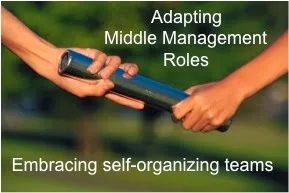The Role of Middle Management in an Agile World
Blog: Agile Adoption Roadmap
When discussing Agile roles, there is much written about the Scrum Master, Product Owner, Development Team, and Customer. But there is little written about what the Middle Manager should do in an Agile World. Note, when I talk about Middle Manager, I am talking about the Line Manager, Functional Manager, Manager, and Director level manager.
I recently discussed the middle management roles within an Agile context to several different middle managers. They each had an interesting perspective on what it was like when their teams became Agile. Here are two excepts:
- The Functional Manager who was also the team's Line Manager noted that they spent much less time on directing the team on what to work on since the work was now coming out of the Product Backlog. I told him that yes this is big adjustment. He needed to focus on ensuring that his team members had the right skills, understood the Agile principles, and were given the education they needed to become a fully cross-functional team.
- In talking to a Director who now has 3 self-organizing teams, she was telling me that she was having a hard time knowing what to do since she felt she had to get more hands-on. I told her by backing off, helping educate the team members around their new roles, and then allowing the teams to self-organize around the work was the right thing to do. She needed to provide more vision level focus to connect the organization’s strategies to the product visions. She commented that this was very different from the more traditional management role she had been used too.
Ultimately, it is important to understand that middle management are critical to the success of an effective Agile deployment. They are the lynchpin between the executive’s vision for Agile and middle management's willingness to allow Agile to thrive on a team. If they are engaged and buy into Agile, then the change may succeed. Even when executives buy in, if middle management does not do likewise, they can block a team's ability to succeed with Agile.

If middle management don’t understand their role in the new order or feel threatened by the change, they may become Deceivers or Deniers and block the success toward Agile. Because of this, it is critical that middle managers are educated on Agile at the same time their teams are
Middle management must adapt their role and learn to gently back away from their functional leadership, act more as servant leaders who trust their teams, help them remove roadblocks, and support the agile principles and practices. They may attend the Sprint Review to see progress of the working functionality and the Daily Stand-up to gain a sense of team progress. Middle management must also learn how to establish the concept of bounded authority where teams can make their own decisions and commit to their own work. The balance is that managers keep limited responsibilities to provide a vision and support their staff, while allowing teams ownership of their work. Finally, middle management must be willing to be transparent about what is going on in the organization and be willing to communicate this information to the team.
Other Roles that may suit Middle Management
Often middle management have less to do in an Agile world. The good news is that they may consider options such as changing their role to Resource Manager, where they manage more people but do not own an organizational functional area. They may consider a Product Owner role if they have been engaged in collecting requirements and interacting with customers. Although this role should no longer be managerial (i.e., not direct reports), a PO helps shape the product by collecting and grooming the requirements and collaborating with the team. They may also move to another Functional Manager role where there is still a need for this role. And some will remain their current middle management leadership roles. If they continue to want to do the more traditional middle management roles, they may consider looking for companies that continue to look for the more traditional roles.
How Middle Management can evaluate themselves in an Agile World
Here are a few questions middle managers can ask themselves to see how aligned they are in managing teams in an Agile World. These questions are based on material from "The Manager's Role in Agile" by Michael Spayd and Lyssa Adkins.
- Are you allowing for self-organizing teams while still providing servant leadership?
- Are you removing command and control elements while providing bounded authority?
- Are you supporting the Agile values and principles starting with marshaling a culture toward delivering value?
- Do you remove the language of false certainty, big-up-front planning and requirements, and big batches?
- Do you remove the significant roadblocks that hinder an agile team’s progress?
- Do your teams perceive you as a coach and leader more than as a manager?
- Are you helping the team with supporting their people and equipment needs?
- Are you adapting the performance objectives to support team accomplishments to ensure they are delivering the highest value?
- Do you help the teams when they have external team dependencies in order to get their work done?
- Are you fostering a learning organization? Do you provide teams the time to get educated (training, coaching, etc.)?